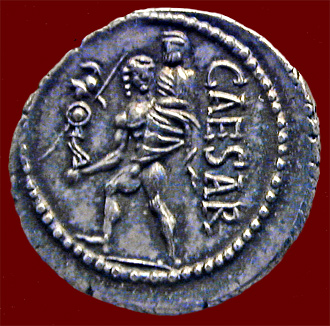
 |
| denarius of Julius Caesar, 47-46 BCE, Allard Pierson Museum |
This coin was issued by Julius Caesar in 47-46 BCE; it depicts Aeneas leaving Troy, carrying his father Anchises on his shoulder and the Palladium in his right hand. According to Greek mythology, the Palladium was a small wooden statue of Athena that fell from the heavens into Troy; the safety of the city of Troy depended on their keeping the statue within their walls. Roman tradition before Vergil wrote the Aeneid claimed that Aeneas had taken the statue and brought it with him to Italy, where it was kept in the Temple of Vesta and supposedly transferred its protection to the city of Rome.
 |
| sestertius of Lucilla, 164-67 CE, Pergamon Museum |
The coin was issued for Lucilla, daughter of the emperor Marcus Aurelius, sister of Commodus, and wife of Lucius Verus. The goddess Vesta is shown standing beside an altar with a burning flame. She holds in her right hand a simpulum (a long-handled ladle used by a pontifex (a type of priest) for pouring wine at sacrifices. On her left shoulder she holds the Palladium, the city- protecting wooden statue of Athena.
Close this window when finished